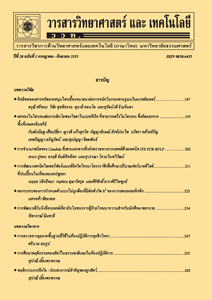พลังงานทดแทนชุมชนจากเชื้อเพลิงชีวมวลอัดแท่งจากทางมะพร้าว
Main Article Content
Abstract
บทคัดย่อ
งานวิจัยนี้เป็นการศึกษาความเป็นไปได้ในการนำทางมะพร้าวมาผลิตเป็นเชื้อเพลิงชีวมวลอัดแท่งสำหรับใช้เป็นพลังงานทดแทนในชุมชน โดยศึกษาความเหมาะสมทางเทคนิค คือ สมบัติด้านเชื้อเพลิงของแท่งเชื้อเพลิง และความคุ้มค่าทางเศรษฐศาสตร์ของการผลิตแท่งเชื้อเพลิงเพื่อประเมินความเป็นได้ในการบริหารจัดการโดยชุมชนในทางปฏิบัติ แท่งเชื้อเพลิงในงานวิจัยนี้ใช้น้ำแป้งมันสำปะหลังที่อัตราส่วนต่าง ๆ เป็นตัวประสาน อัดขึ้นรูปด้วยวิธีอัดเย็นและได้ทำการทดสอบสมบัติทางด้านเชื้อเพลิงตามมาตรฐาน ASTM ผลการศึกษาพบว่าค่าความร้อนของเชื้อเพลิงอัดแท่งชีวมวลที่ได้มีค่าอยู่ในช่วงประมาณ 2,865-4,185 แคลอรี/กรัม และมีประสิทธิภาพการใช้งานเชิงความร้อนอยู่ในช่วงประมาณร้อยละ 8.55-13.36 ค่าความชื้น สารระเหย ปริมาณเถ้า และคาร์บอนคงตัวของแท่งเชื้อเพลิงชีวมวลที่ได้อยู่ในช่วงร้อยละ 7.25-23.40, 67.62-76.31, 3.33-5.28 และ 2.26-10.71 ตามลำดับ อัตราส่วนผสมที่ให้คุณสมบัติด้านเชื้อเพลิงดีที่สุด คือ ทางมะพร้าว 1 กิโลกรัม ต่อน้ำแป้งมันสำปะหลัง 1.25 ลิตร การวิเคราะห์ความคุ้มค่าทางเศรษฐศาสตร์พบว่าอัตราผลตอบแทนภายในร้อยละ 15.6 มูลค่าปัจจุบันสุทธิเท่ากับ 48,178 บาท และระยะเวลาคืนทุนเท่ากับ 5 ปี 1 เดือน ซึ่งอยู่ในเกณฑ์ที่เหมาะสมต่อการลงทุน โดยปัจจัยที่เป็นความเสี่ยงในการบริหารจัดการและมีผลต่อผลตอบแทนของโครงการมากที่สุด คือ ราคาเชื้อเพลิง และจำนวนเชื้อเพลิงที่ผลิตได้ต่อวัน รองลงมา คือ ค่าแรงคนงาน จำนวนวันที่ผลิต และราคาเครื่องจักร ตามลำดับ
คำสำคัญ : พลังงานทดแทน; เชื้อเพลิงชีวมวลอัดแท่ง; ทางมะพร้าว
Abstract
The objective of this research is to study the technical and economic feasibility of biomass briquette production from dried coconut leaf in order to use as alternative energy in communities. The biomass briquette in this research was produced by cold-press technique mixing with tapioca starch at different ratios. The fuel properties of briquette were analyzed according to ASTM standards. The test results showed that the heating value of the briquette is in the range between 2,865-4,185 cal/g and the heat utilization efficiency is in the range between 8.55-13.36 %. The moisture, volatile, ash, and fixed carbon content are 7.25-23.40, 67.62-76.31, 3.33-5.28, and 2.26-10.71 %, respectively. The ratio with the best fuel property is coconut leaf 1 kg : tapioca flour water 1.25 liter. The economic feasibility of briquette production was analyzed using net present value (NPV), internal rate of return (IRR) and payback period (PB). The analysis results show that the production of biomass briquettes from coconut is economically feasible with NPV = 15.6 %, NPV = 48,178 THB, and payback period = 5 years and 1 month. Moreover, the sensitivity analysis results show that the most influential risk factors of the briquette production are fuel price and number of fuel produced daily, followed by labor wages, number of production days a year, and price of machines, respectively.
Keywords: renewable energy; briquette; coconut leaf


